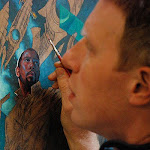The next step after bringing my Unicorn thumbnail where I wanted it to be was to turn it into a finished drawing. I planned to make the painting 18 inches by 24 but a smaller drawing often works for me so it would be proportional at 9 inches by 12. Working full size or even larger can work well too especially for drawing action, motion or just anything that needs to be loose and flowing. The large space lets you move and use your whole arm to sketch broad strokes. But I planned to get in and really plan the details of my piece working with pencil. First step, stick that thumbnail in my old school Art-O-Graph.
Any photo, drawing or tracing is just mounted inside the hinged door with tape. Close the door, turn down the lights and turn it on. The drawing is projected onto the drawing table where I can lay down any paper I want and trace my own image at any new size. I can also unmount the Art-O-Graph and shine the image on the wall which can create a bigger blow-up than any photocopier will ever do. It's finicky, awkward and sometimes very frustrating if I bump the machine and throw off your drawing when it's half traced but for my purposes here it's a very quick and easy way to turn my little thumbnail into a full size drawing. When tracing it off it's best to forsake detail and just sketch in the major outlines. I'm not drawing right now, just laying down the framework. I take the paper I'm working on, rule out the border at the correct size the put it under the projection and adjust until it fits (I plan ahead and make the thumbnail roughly the right proportions.) This stage gives me an opportunity to tilt the paper and change the angle of the drawing. I can also crop in tightly or leave room around the edge for more background.
Can this all be done with a scanner, bringing your drawing into Photoshop? Of course and once it's there you have a lot of tools at your disposal that aren't possible here. But this is an example of doing everything the old school method and in a lot of ways it's not harder or less efficient just different.
Now I have a framework drawing that hopefully captures all the proportions I planned so carefully in the thumbnail stage. But there is still room to move elements around in relation to each other and adjust the layout. I work on tracing paper so I can trace off portions of the drawing then put them underneath.
They show through the existing drawing and I can tilt and move them
around trying out different positions for the major elements. There is nothing worse than carefully rendering your subject then stepping back to see it's an inch away from where it should be. No problem, I trace it and move it and, at the same time, tilt it to the left or right or flip it backwards and see if there's a better angle for it in relation to the rest of the picture. This is all more stuff that is very easy in Photoshop and digital artists are taking advantage of the ease with which they can make these changes.Working on tracing paper I make sure I don't stick with a bad drawing just because it's "there".
It does take a lot of drawing, erasing and shifting but it's all time well spent building the right layout. Then it's time to get out my reference materials and tighten up details and lay in shading secure in the knowledge that it's the best drawing I can make it this time.




















